Marianne Vasara-Aaltonen
A couple of weeks ago, our project organised the seminar “Juries, Jurors and Legal Literacy in Nineteenth- and Twentieth-Century Ireland and Finland” with presentations by Niamh Howlin (University College Dublin), Mia Korpiola (University of Turku) and Anna Kuismin (University of Helsinki). Of course, jurors – as laymen without any formal legal training – are central to the topic of popular legal literacy which is the focus of the project.
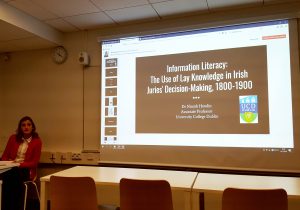 Niamh Howlin began the session with her talk “Information Literacy: The Use of Lay Knowledge in Irish Juries’ Decision-Making, 1800–1900” in which she presented different types of Irish juries and their jurors. When thinking of juries, trial juries often come to mind first but juries were used in different other situations such as valuations and medical inquests, too. This meant that jurors could possess not only legal but also commercial and medical knowledge.
Niamh Howlin began the session with her talk “Information Literacy: The Use of Lay Knowledge in Irish Juries’ Decision-Making, 1800–1900” in which she presented different types of Irish juries and their jurors. When thinking of juries, trial juries often come to mind first but juries were used in different other situations such as valuations and medical inquests, too. This meant that jurors could possess not only legal but also commercial and medical knowledge.
The Grand Jury made the decision in a criminal case whether or not there was a strong enough case to indict the accused, whereas the Petty Jury would then decide on the actual case in trial. The Grand Jury was manned with gentlemen of high social status and they wielded great political power, too, as they were also involved in local government. The Petty Jury, in turn, was divided into a Common Jury and a Special Jury. The Common Jury consisted of twelve men, and with time the property requirement became the most important ground for their selection. This made it rather difficult, especially in the countryside, to find suitable men for the juries as being juror on the Common Jury was burdensome, unpaid and sometimes jurors even faced threats and violence. However, the flipside of having a small pool of potential jurors was that many jurors served for years and in the process gained experience and knowledge of the law. Indeed, when the property qualifications of jurors were lowered in 1871, this led to a chaotic situation with many new jurors who were without any legal experience or understanding of the procedure. It was also possible to use a Special Jury instead of a Common Jury if the prosecutor asked for this and the court agreed. Special Juries were especially used in commercial cases. These jurors were men of higher social standing, or as the nineteenth century progressed, increasingly middle-class businessmen and tradesmen who provided a source of expertise. As men qualified for Special Juries were even more difficult to find they served for long periods and gathered a wealth of knowledge on legal matters, too.
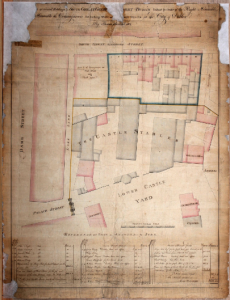
Wide Streets Commission Map (WSC 187), Dublin City Archive.
Next, Howlin shifted the focus to the other, non-trial, juries. We learned about valuation juries, such as the Wide Streets Juries which in Dublin functioned from the mid-eighteenth to mid-nineteenth centuries. These juries had broad powers and had a great effect on city development. Jurors had to evaluate the value of houses which were to be the subjects of compulsory purchase. This involved estimating value, inspecting legal documents, conveyancing etc., and was no easy task. Jurors were often wealthy and disinterested businessmen, and they, too, often functioned repeatedly in these juries which increased their legal knowledge. They also had to be mathematically literate to be able to perform their duties. Compulsory purchases were a controversial issue and using townsmen as valuation jurors lent the venture some legitimacy in the eyes of other townsmen.
Other types of juries are those that make an inquest into medical questions. Howlin discussed the Coroner’s Jury, the Matrons’ Jury and the Lunacy Jury. The Coroner’s Jury made an inquest on the dead body, it could hear witnesses and would then make a verdict on the cause of death. As the name suggests, the Jury of Matrons consisted of women who in civil or criminal cases would assess whether a woman was pregnant or not. This could involve e.g. questions of paternity or the delay of a death sentence. There were no property requirements for these women, but they had to be married or widowed and had to have experience of childbirth either directly or through assisting it. The Lunacy Jury was staffed with men who had the same qualifications as those functioning in Special Juries. The Lunacy Jury had to decide whether a person was sane enough to control their property. This meant that there were many competing financial interests to deal with as relatives and the Crown all had an interest in the matter. Finally, Howlin also discussed the Mixed Jury, used in civil and criminal cases involving foreigners, and the Market Jury which inspected that rules for example regarding food safety and weights and measures were followed in markets.
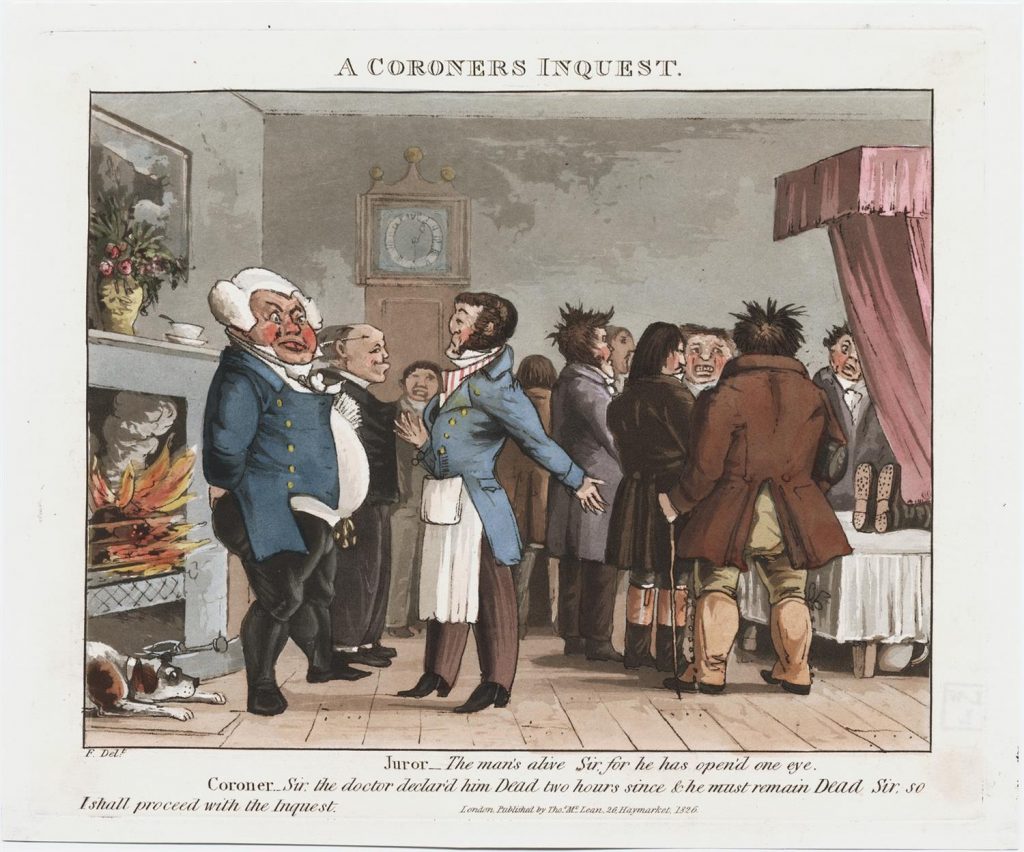
A coroner’s inquest,
Published by Thos. McLean, 26 Haymarket, London, 1826. Digital Collection: Lewis Walpole Library.
The Matrons’ Jury is interesting in comparison with Finland and Sweden. Similarly as in Ireland, also in Sweden and Finland women were responsible for assessing gynaecological matters in court cases – often involving the death of a newborn. However, here, the task was not in the hands of female jurors but rather trained midwives were used as expert witnesses in court already in the eighteenth century, as Kirsi Vainio-Korhonen has shown. It was not simply their gender and experience of childbirth that qualified them for the task, but the medical knowledge that these professional women had acquired through their training and practice.[1] In Ireland, it was in the nineteenth century when the tide turned towards using physicians with medical knowledge as expert witnesses in such cases instead of juries. Increased medical professionalisation eventually pushed out the Matrons’ and Lunacy Juries in the late-nineteenth century.
None of the jurors in any of these juries were required to have any legal training. They were laymen when it came to the law, but could possess some other, e.g. commercial expertise which was of value in judging cases or evaluating property. As many of them acted as jurors for several years they gathered practical experience of the law and the legal procedure. Being members of the community, they also had more legitimacy in the eyes of their peers than trained professionals would have had: it was easier to accept their decisions, for example in the case of compulsory purchases.
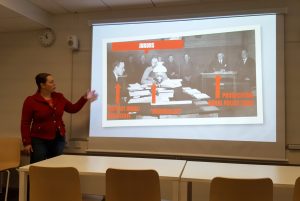 Mia Korpiola focused on Finnish juries in her presentation ”Perceptions of Juries and Jurors in Finnish Lawyer Memoirs, ca. 1910–1960”. The local peasant jury (Finn.: lautakunta, Swed.: nämnd) had been functioning in the countryside since times immemorial, and already in the Middle Ages the jurors as co-judges had become a permanent feature throughout the assizes. Still today, jurors are used in Finland, but the types of cases in which they appear is limited. In her talk, Korpiola examined how these laymen jurors were perceived in twentieth-century lawyer memoirs.
Mia Korpiola focused on Finnish juries in her presentation ”Perceptions of Juries and Jurors in Finnish Lawyer Memoirs, ca. 1910–1960”. The local peasant jury (Finn.: lautakunta, Swed.: nämnd) had been functioning in the countryside since times immemorial, and already in the Middle Ages the jurors as co-judges had become a permanent feature throughout the assizes. Still today, jurors are used in Finland, but the types of cases in which they appear is limited. In her talk, Korpiola examined how these laymen jurors were perceived in twentieth-century lawyer memoirs.
The Finnish jurors acted as co-judges, swearing the judge’s oath, and until the 1970s the court itself selected the jury members. Often, they functioned at the district courts’ assizes for decades which meant that, even though they had no formal legal learning, they gathered a lot of practical experience about the law and the functioning of the judiciary. The legal knowledge they had acquired made it possible for them to also perform other law-related tasks in their communities, such as working as summoners, surveyors or lay advocates. They gathered legal literacy that was needed in the every-day management of legal and administrative affairs in rural Finland where learned advocates were virtually non-existent. Thus, it is natural that jurors often had higher social status in their peasant communities, even though they were peasants themselves, too.
After their studies, lawyers would often come into contact with jurors when they were doing their court training as trainee judges (Finn.: auskultointi) fresh out of university. When these inexperienced new lawyers worked as judges in the district courts it was sometimes actually the jurors that had the most experience of administering justice, and it was useful for the court to have these experienced jurors judging together with the judge. A unanimous jury could overrule the judge. Jurors could also help by interpreting, for example, if the judge could not understand the local dialect of a witness. It hasn’t been researched when the first female jurors were appointed, but in many places, it did not happen until 1970 when the law required juries to include women. However, even before 1970 there was no legal hindrance to appoint female jurors. The situation was slightly different in towns which did not have juries but traditionally had lay judges (Finn.: kunnallisraatimies / kunnallisneuvosmies) who sat together with learned judges (Finn.: oikeusraatimies / oikeusneuvosmies) in the town courts. The first female lay judge in a town court was appointed in Iisalmi already in 1928. One can note how the traditional image of a male juror must have dominated in the countryside for a long time.

District court session in Juuka in 1907, photographed by Ville Tuhkanen. Kansatieteen kuvakokoelma, Karjalaisen osakunnan kokoelma.
The lawyer memoirs that Korpiola has gone through give a nuanced picture of the functions of the jury during the assizes. The jury was important in setting the tone and culture of the court – this was especially true if the judge was young and inexperienced. When the lawyers wrote about jurors in their memoirs, it was usually positively: respecting the experience they had through years of jury service and not calling into question their knowledge despite the fact that they were laymen. However, they also tell about the alcohol use of jurors – even during court sessions. Some jurors were even quite the pranksters: one lawyer notes how on one occasion some jurors painted a moustache on the face of their fellow-juror who was so drunk that he had passed out. Generally speaking, one could note that the atmosphere of the court was more serious on the west coast (with a strict temperance movement in Ostrobothnia), and the further east one went, the more relaxed the atmosphere – as well as the drinking habits of jurors – became.
 Next, Anna Kuismin talked about the images of jurors in Finnish folklore and fiction from the 1820s to the 1920s. Jurors, as central figures in their rural communities, appear in various types of folklore and literature: in sayings, jokes, charms, poems, stories and novels. There are several motifs regarding jurors that can be found repeatedly in Kuismin’s material. The idea of a “dozing juror” appears in many jokes and sayings. For example: “What is the requirement for a juror? He has to appear to be awake when sleeping at court and he cannot snore too loudly or fall on the floor more than five times a day.” The drinking habits of jurors can also be seen in Finnish jokes. There are also many jokes about jurors making wrong verdicts because they were dozing during the proceedings. An especially popular joke concerned a paternity case where a sleeping juror accidentally claimed to be the father. This joke appears as a “true story” around the country in the nineteenth century and was printed in newspapers, too.
Next, Anna Kuismin talked about the images of jurors in Finnish folklore and fiction from the 1820s to the 1920s. Jurors, as central figures in their rural communities, appear in various types of folklore and literature: in sayings, jokes, charms, poems, stories and novels. There are several motifs regarding jurors that can be found repeatedly in Kuismin’s material. The idea of a “dozing juror” appears in many jokes and sayings. For example: “What is the requirement for a juror? He has to appear to be awake when sleeping at court and he cannot snore too loudly or fall on the floor more than five times a day.” The drinking habits of jurors can also be seen in Finnish jokes. There are also many jokes about jurors making wrong verdicts because they were dozing during the proceedings. An especially popular joke concerned a paternity case where a sleeping juror accidentally claimed to be the father. This joke appears as a “true story” around the country in the nineteenth century and was printed in newspapers, too.
Another theme in juror jokes concerns the social status. Jurors were seen as hobnobbing with gentlemen and trying to imitate their dress and habits. Some sayings also connected jurors with images of hell and the devil: e.g. Vainoo ninko piru lautamiestä, i.e. someone harasses someone else like the devil harasses a juror. Here, Korpiola reminded us that the devil appears often already in medieval legal iconography, for example standing behind someone taking an oath, and reminding people of the possibility of perjury. The sacral element was present in court proceedings, and still in the 1950s, the assizes would begin with a prayer. It is not that surprising, then, that the devil also appears in folklore about jurors. Howlin told us that many of the juror jokes have parallels in Ireland, as well. However, while the folklore on jurors in Finland seems to be almost completely negative, in Ireland one can also find positive attributes on jurors.
The fiction that Kuismin has examined also depict jurors socialising with important men of the community, showing off their legal knowledge and adapting new habits. Some of them are shown as being rich and proud as well as drinking heavily. However, in these stories and novels the jurors’ positive traits can also be found, as they are also portrayed as being respectable and conscientious.
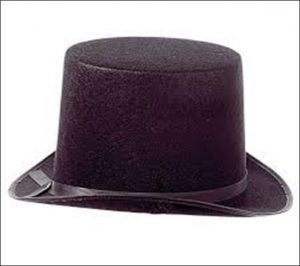

Combining the mentions of jurors in Korpiola’s lawyer memoirs and Kuismin’s folklore and literature, one can assume that there is some truth to all the stories mentioning jurors and their excessive drinking, for example. However, negative aspects are perhaps more emphasised in folklore whereas the lawyer memoirs tend to see jurors as a valuable and respected part of the court – despite sometimes drinking heavily. Perhaps then, as Kuismin noted, folklore on jurors also exemplifies the envy that other, less successful members of the peasant community felt towards the jurors. Jurors were the middlemen between the common people and the authorities which was not always a grateful position to be in. Also, in fiction, it is important to have a villain. Good versus bad and someone falling from grace are typical literary themes which one can find in these writings, as well. One can also see a resemblance between stories about jurors and stories about so-called corner secretaries (Finn.: nurkkasihteeri), i.e. lay advocates who had a dishonest reputation. It is important to keep in mind, though, that the idea of a bad juror or bad lay advocate is not necessarily a thorough depiction of reality. In reality, both groups of people were extremely necessary in the rural community which could not yet rely on legally trained professionals.
Finally, we had a discussion about the similarities and differences of juries and jurors in Ireland and Finland. Obviously, jurors in both countries learned the law by doing; many jurors served for years – in Finland even for decades – which gave them a strong practical knowledge of legal affairs. While in Ireland there were no manuals for jurors, in Finland jurors could make use of the many legal handbooks meant for commoners that appeared throughout the nineteenth century. They were not specifically aimed at jurors, but many jurors who also took care of other legal matters in their communities probably found use in such manuals. A common feature is also that – despite some ridicule in jokes and sayings – in general, jurors were respected for their service in their communities, both in Ireland and in Finland. Using juries was also a way for the authorities to save money in comparison to using trained professionals: the Finnish jurors got their compensation as a portion of the local judiciary tax and most of the Irish jurors were unpaid. As for distinctions, in Ireland juries were used for many purposes for which in Finland some other municipal body would have been appointed. On the other hand, Finnish jurors took care of some matters that would have fallen into the hands of a specialised jury in Ireland. And, of course, one must remember that in Finland, the jury system only concerned the rural district courts. Most town courts also had lay members but these were not jurors. They were appointed judges just as the legally trained judges were. Despite some differences, it would seem that the common denominators of learning law by doing and the overall respect for jurors were the most important features both in Ireland and in Finland.
It was a really inspiring seminar, for which I thank Mia and Anna, and especially our guest speaker Niamh!
[1] Kirsi Vainio-Korhonen: ”Midwives. Birthing care professionals in eighteenth-century Sweden and Finland”, in Early Professional Women in Northern Europe, c. 1650-1850 (eds. Johanna Ilmakunnas, Marjatta Rahikainen and Kirsi Vainio-Korhonen), Routledge, London and New York 2017, and in Finnish, Kirsi Vainio-Korhonen: Ujostelemattomat. Kätilöiden, synnytysten ja arjen historiaa, WSOY, Helsinki 2012.
Vastaa